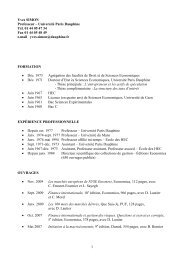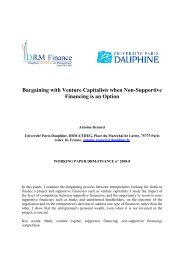Souad AJILI - CEREG - Université Paris-Dauphine
Souad AJILI - CEREG - Université Paris-Dauphine
Souad AJILI - CEREG - Université Paris-Dauphine
Create successful ePaper yourself
Turn your PDF publications into a flip-book with our unique Google optimized e-Paper software.
R i − R f = α i + ß i (R M − R f ) + s i SMB + h i HML + ɛ i<br />
The results show that the coefficient α i is:(i)Negative for portfolios located in the<br />
extreme quantiles of the stocks of small capitalizations and low ratio book to market<br />
and (i)Positive for portfolios located in the extreme quantiles of the stocks of big<br />
capitalizations and high book to market ratio. In addition to these results on the<br />
extremes, the coefficient α i is not significantly different from zero; which makes it<br />
possible to affirm that the three factor model explains cross-section stock returns.<br />
There are many explications for size and book to market anomalies. They can<br />
be summarized in the following points: The premium of the financial distress is<br />
irrational ( Lakonishok et al. (1994) and MacKinlay (1995)). Three arguments<br />
justify it: It can express an over-reaction of the investors. The second argument<br />
is relative to the empirical observation of low stock return of firms with distressed<br />
financial situation, but not necessarily during period of low rate of growth of GNP<br />
3 or of low returns of all stocks. Lastly, diversified portfolios of stocks with, as well<br />
high as low, ratio book to market; have the same variance of returns.<br />
Other researchers documented other arguments 4 which can replace the premium<br />
of the financial distress and validate the CAPM: (a) Survivor bias( Kothari et al.<br />
(1995)): But it should be noticed that even if the critic of the survivor biais is true, it<br />
is not necessarily in favor of the CAPM ( Kim (1997), Barber and Lyon (1997)). (b)<br />
Data-snooping( Black (1993), Black, Lo and MacKinlay (1990)): An extrapolation<br />
of data can lead to false conclusions, so how we need the out-of-sample tests. Fama<br />
and French (1996b) and Fama and French (1996a) reject this biais 5 . Moreover,<br />
the relation between stock returns and the book to market ratio was confirmed by:<br />
Davis (1994) on data over a long period; Chan et al. (1991) on Japanese data and<br />
Barber and Lyon (1997) on data on the financial institutions 6 , among others. (c)<br />
Bad market proxies : Indeed, according to this argument, the model of asset pricing<br />
to be retained is that of the CAPM and because we don’t know the market portfolio<br />
we have anomalies. This is why, the “real” βs are not observed. This problem is<br />
called errors-in-variables( Kim (1997)).<br />
Nevertheless, there are many attempts to give theoretical explanation for the<br />
three factor model. Berk et al. (1999) give a micro-economic model of the firm<br />
which integrate options of growth investments. The simulations of the model give<br />
3 Gross National Product: Chen (1991) indicate that the expected stock returns are negatively<br />
correlated with the present rate of growth of GNP and positively correlated with its future rate of<br />
growth.<br />
4 we limit the presentation to three biais related to the use of the data but there exists others;<br />
such as errors of corresponding market and accounting data or look ahead bias.<br />
5 Fama and French (1996b) and Fama and French (1996a) give four arguments: the premium<br />
of the financial distress is not special to a particular sample since it is checked for different periods.<br />
It was also the subject of many studies made on international data. The size, book to market<br />
equity, earning to price and cash flow ratios, indicators of expected incomes (Ball 1978), have a<br />
great utility to test models of asset pricing like the CAPM. And in fourth point, the limited number<br />
of the anomalies excludes the assumption ofdata-mining.<br />
6 Barber and Lyon (1997) confirmed the relation between the size, the book to market ratio and<br />
the stock returns, published by Fama and French (1992), for the financial institutions (Fama and<br />
French considered only the non-financial firms).<br />
4



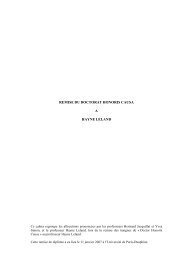

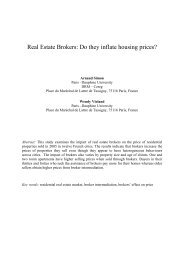
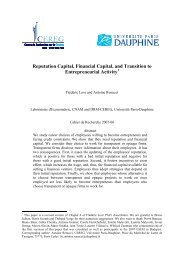

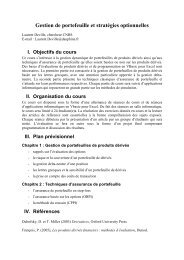

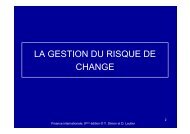
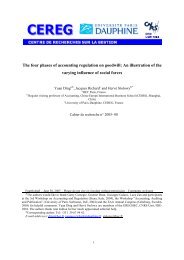
![& 6 ] ^ F ]^ - CEREG - Université Paris-Dauphine](https://img.yumpu.com/33326502/1/184x260/-6-f-cereg-universitac-paris-dauphine.jpg?quality=85)

